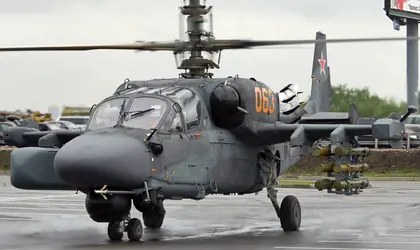Russia’s top-tier helicopter gunship, the $16 million Ka-52 Alligator, is being knocked down from skies above Ukraine at a pace of better than an aircraft a day, Ukrainian military sources said on Tuesday, without saying exactly how it was done.
Ukrainian air defense force operators from June 16 to 19 brought down five Kamaz Ka-52 attack helicopters, the air force statement said.
JOIN US ON TELEGRAM
Follow our coverage of the war on the @Kyivpost_official.
Russians are building flying tanks.
— Trollstoy (@Trollstoy88) June 19, 2023
Ka-52 continues to fly nonchalantly even with a broken tail.
Any other helicopter without a tail rotor is not capable of a similar level of survivability with this kind of damage. pic.twitter.com/Se8Xje1qVi
Ukraine’s air defense units are responsible for protecting national airspace and operate systems ranging from fighter jets to ground-based anti-aircraft missile and gun batteries.
- Access the latest Ukraine news coverage for today.
- Look at the latest Ukraine news that was released today.
The official Kyiv statement published on the air force’s Telegram channel confirmed the location of only one shootdown: “on the Donetsk front at around 23:00 on 19 June”.
Russia-controlled media in mid-June credited Ka-52 gunships for the destruction of three German Leopard 2 tanks and eleven US-made Bradley infantry fighting vehicles in a series of nighttime ambushes on June 10, in the southern Orikhiv sector. Official Ukrainian statements acknowledged some of the losses but claimed that most of the hit vehicles would be recovered and repaired.
The Kremlin-supported Readovka information platform on June 19 reported a sixth Ka-52, also operating in Ukraine, took a direct missile hit to its tail but was able to return to base. Other sources published video of a Ka-52 flying despite its entire tail having been blown off but did not directly link the damaged aircraft with combat operations in Ukraine.

Putin Vows ‘Destruction’ on Ukraine After Kazan Drone Attack
⚡️Video of the Ka-52 helicopter when its tail fell off https://t.co/GSD2eE2Idm pic.twitter.com/E6NC9EDI1G
— War Monitor (@WarMonitors) June 19, 2023
The Kamaz Ka-52 Alligator has been billed by the Kremlin as the world’s best helicopter gunship due to its counter-rotating rotors, “smart” targeting systems, thick armor and powerful armament. A heavily-advertised feature of the aircraft is the Vikhr attack missile, a weapon Moscow claims can destroy any tank at a 10 km. range, enabling Ka-52 gunners to pick off targets well outside the reach of most Ukrainian air defense weapons.
Ukraine’s 36th Marine Brigade published a colorful account of a Sunday shootdown, reportedly taking place after a Ka-52 pilot flew too close to Ukrainian lines, and a Marine gunner with callsign “Lyto” hit it with a shoulder-launched, short-range Igla missile.
“The pilot of the Russian helicopter… was moving… at an altitude of less than twenty meters, and the distance to the Ukrainian positions was more than four kilometers… so ‘Putin's vulture’ felt almost invulnerable... The missile fired from the Igla MANPADS hit the tail projection of the helicopter. Later, ‘Lyto’ and his brothers watched a picturesque picture: the vaunted analog-propellant "Alligator", leaving behind a trail of greasy thick smoke, began to sharply lose [altitude] and disappeared from sight in a few seconds,” the after-action report published on the brigade Telegram channel on June 18 said.
Kyiv Post could not confirm the account but Ukraine’s air force claimed a Ka-52 shot down on that day, and later confirmed the engagement took place in the Donetsk sector. Elements of 36th Brigade have been deployed to that area for months, military sources told Kyiv Post.
Following Kyiv’s early June launch of an offensive in the war’s southern sector, Kremlin propagandists have played up Russia’s Ka-52 fleet as a devastating and highly mobile reserve force Moscow’s generals can deploy to any threatened area to demolish Ukrainian attacks.
Kremlin-controlled media have depicted Ka-52 pilots as heroes defending Russia. A June 20 Izvestiya news agency television report forwarded by high-profile Russian propagandist Boris Rozhin described one pilot as a man who loves children and likes to waggle his helicopter’s wings at children on the ground.
The Armed Forces of Ukraine (AFU) have since Russia’s late Feb. 2022 invasion used a mix of Soviet-era vehicle-mounted anti-aircraft weapons, and hand-held anti-aircraft missiles donated by Kyiv’s Western allies, to battle the Kremlin’s powerful attack helicopter fleet. According to a June 20 situation estimate by Ukraine’s Army General Staff, Ukrainian troops, using various weapons, had shot down 306 Russian helicopters since Feb. 2022.
By Apr. 2023 Ukrainian officials were openly warning of falling stocks of hand-held anti-aircraft missiles like the shoulder-fired Igla and said Russian helicopter gunships could soon be operating above battlefields with near-impunity.
Stocks of the default NATO hand-held anti-aircraft missile, the US-made Stinger, are reportedly at critically low levels following more than a year of deliveries to Ukraine and limited production in the US. The Latvian military, by late April, had emptied its entire stockpile and transferred all its Stingers to Ukraine.
One stopgap measure was a Canadian decision in late May to hand over to Ukraine 43 AIM-9 missiles, a tested anti-aircraft weapon developed by the US. The Norway-US-manufactured NASAMS ground-based launch system can fire AIM-9 as well and, according to open sources, Ukraine currently operates two NASAMS systems, one donated by the US and the other by Canada.
The AIM-9 Sidewinder missile is widely used in NATO air forces. Its maximum range, per open sources, is above 30 kilometers: about three times the range of the Ka-52’s long-range anti-tank missile. The location of NASAMS systems known to be in Ukraine is a military secret.
On June 19, the Ukrainian Air Force published a video of a Ukrainian MiG-29 fighter, in action in unspecified airspace, firing an air-to-air missile at an unidentified target. Some military analysts suggested the weapon was possibly an AIM-9 because some MiG-29s jets currently operated by the Ukrainian air force were donated by NATO members Poland and Slovakia, whose air forces modified the Soviet-era jets to launch NATO-standard missiles like the AIM-9. The missile in the video is blurred out and made unidentifiable on the official Air Force Twitter post.
MiG-29 of the Ukrainian Air Force is ready to say a burning «Hi» to the occupiers pic.twitter.com/UcblGsf4me
— Ukrainian Air Force (@KpsZSU) June 19, 2023
You can also highlight the text and press Ctrl + Enter









